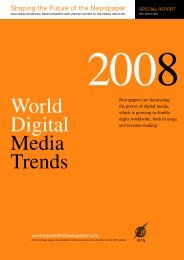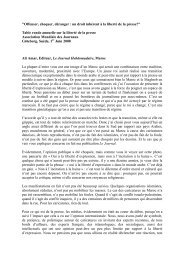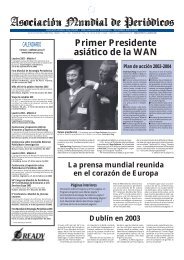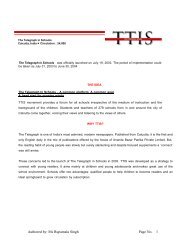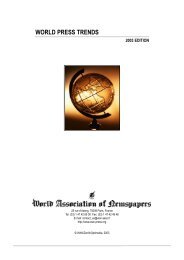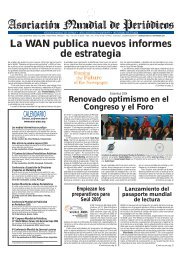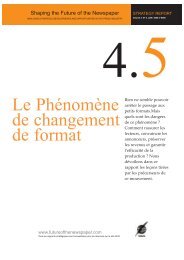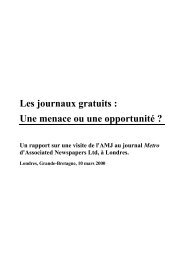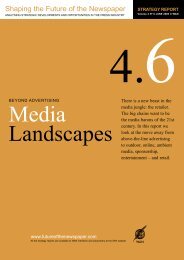MEDIA MARKET DATA - World Association of Newspapers
MEDIA MARKET DATA - World Association of Newspapers
MEDIA MARKET DATA - World Association of Newspapers
You also want an ePaper? Increase the reach of your titles
YUMPU automatically turns print PDFs into web optimized ePapers that Google loves.
spending to the Internet. "Starting last year, a lot <strong>of</strong> people in the traditional media industryhave grown concerned about the future due to pr<strong>of</strong>its <strong>of</strong> newspapers being diverted to theInternet," said Mr Long Xinmin, director <strong>of</strong> General Administration <strong>of</strong> Press and Publication,which regulates China's print media. He was speaking at the China Media Forum 2006 heldhere yesterday. Since China began loosening restrictions on media in the early 1990s,hundreds <strong>of</strong> local newspapers catering to China's growing middle class have sprouted up to<strong>of</strong>fer sports news, entertainment news and other alternatives to staid Communist Party-ownednewspapers such as the People's Daily and Guangming Daily. For the past decade or so, thesemetropolitan newspapers' have grown exponentially, thanks to China's rapid growth. Between1998 and 2003, the country's newspaper circulation rose by 35.69 per cent while advertisingrevenues grew by 87 per cent. Now, the world's largest newspaper market is facing its biggestchallenge ever. A joint study by Qinghua University and the Chinese Academy <strong>of</strong> SocialSciences found that Chinese newspaper advertising turnover has dropped by more than 15 percent since last spring, the first time ever the industry has seen a decline in advertising. Asadvertising accounts for more than 70 per cent <strong>of</strong> most Chinese newspaper revenues, the dropin advertising income has eroded their pr<strong>of</strong>it margin. However, figures illustrating the declinein pr<strong>of</strong>itability are harder to come by because most newspapers are privately owned by localgovernments. Last week, the Hong Kong-listed Beijing Media Corporation issued a pr<strong>of</strong>itwarning for its 2005 earnings, citing a slowdown in advertising revenue, particularly fromreal estate companies. It is the advertising arm <strong>of</strong> the Beijing Youth Daily and the only listednewspaper company out <strong>of</strong> 1,922 newspaper companies in China. The government's measuresto cool down the overheating economy, starting in 2003, targeted the real estate andautomobile industries which are major advertisers. "Since the macroeconomic controls policycame out, our advertising from real estate companies and automobile manufacturers havefallen," said Nanfang Daily Group CEO Fan Yijin. Also, Chinese newspapers are not immuneto the shift to Internet advertising which has clouded the outlook <strong>of</strong> newspapers around theworld. While spending on newspaper advertising has dropped, spending on China's Internetadvertising rose 78.4 per cent to 4.17 billion yuan (S$842 million) last year, according toiResearch market research firm. At the forum yesterday, more than 260 newspaper andmagazine executives wrestled with how to adapt to this new business environment whereyounger readers prefer to get their news online for free. Most industry experts agreed that theInternet's growing popularity does not necessarily mean that newspapers will be driven toextinction, as Micros<strong>of</strong>t founder Bill Gates once predicted. Unlike blogs or most otherInternet companies, newspapers have the resources necessary to send journalists into the fieldto report the news. "Baidu will not manufacture its own content. Our primary responsibility isto help people find the information they are looking for," said Mr Liang Dong, vice-presidentat China's largest search engine Baidu, which has benefited from the growing Internetadvertising market. http://www.asiamedia.ucla.edu/article.asp?parentid=44054; April 25,2006JapanDentsu Inc., Japan’s largest ad agency, on Feb. 20 released its annual advertising sales reportfor 2005. The report says total ad spending, covering all sectors, rose 1.8 percent from 2004,hitting 5.9625 trillion yen in a second consecutive year-on-year increase. Breaking adspending down by category, each <strong>of</strong> the four categories <strong>of</strong> newspapers, magazines, radio andtelevision suffered declines in ad sales, dropping 0.7 percent in total. Ad spending innewspapers fell 1.7 percent to 1.0377 trillion yen, reversing the first year-on-year gain in fouryears registered in 2004. <strong>Newspapers</strong>' share <strong>of</strong> total ad spending fell 0.6 percentage points to17.5 percent. Ad spending on television fell just 0.1 percent in its first year-on-year drop inthree years. However, ad spending on the Internet continued to climb, surging 54.8 percent.22





